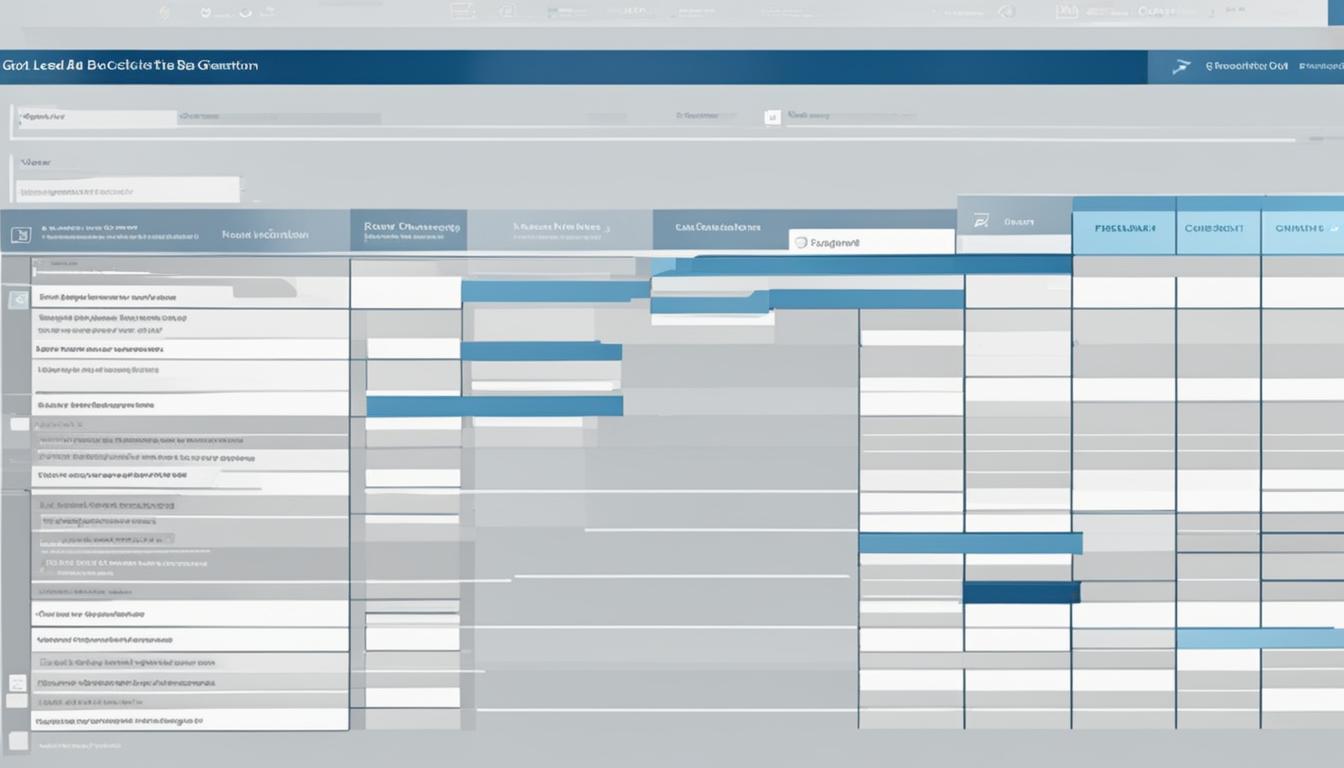Did you know that companies that conduct thorough market analysis are 32% more likely to achieve stable growth and gain a competitive edge? Market analysis is a crucial task that helps companies understand their target market, identify areas for growth, and create strategies based on data-driven insights.
Key Takeaways:
- Market analysis is essential for businesses to unlock insights and drive growth.
- A well-executed market analysis can increase the likelihood of sustained business growth by 32%.
- Businesses can understand their target audience and make informed decisions by conducting a thorough market analysis.
- Market analysis involves a six-step process that covers defining objectives, collecting data, analyzing data, validating findings, monitoring and refining strategies, and maintaining a strategic vision.
- Businesses should focus on collecting and analyzing relevant data while avoiding the storage of unused data.
Define the Business Objectives and Audience
At the core of a successful market analysis is a clear understanding of your business objectives and target audience. This critical first step sets the foundation for gathering relevant data and insights that will drive informed decision-making.
By defining your business objectives, you establish the purpose and direction of your analysis. You need to ask yourself, “What do we want to achieve?” and “What specific goals are we aiming for?” This clarity enables you to focus your efforts and resources effectively, ensuring that your market analysis aligns with your overarching business strategy.
In addition to defining your business objectives, it is equally essential to identify your target audience. Who are the individuals or groups that your products or services cater to? What are their demographics, interests, pain points, and motivations? Understanding your target audience allows you to gather the right data and insights to drive impactful decision-making. It helps you tailor your analysis to capture accurate information and relevant market trends.

Developing a Market Analysis Framework
In order to guide your market analysis effectively, it is beneficial to develop a framework that outlines the key components and steps involved. A market analysis framework provides a structured approach, ensuring you cover all the necessary aspects and don’t overlook any critical elements. This framework may include:
- Business Objectives: Clearly define your goals and objectives, ensuring they align with your company’s overall vision and mission.
- Target Audience Identification: Thoroughly research and identify your ideal customer segments based on demographics, behaviors, and preferences.
- Data Collection Methods: Determine the most appropriate methods for collecting data, including surveys, interviews, focus groups, and secondary research.
- Data Analysis Techniques: Select the relevant data analysis techniques and tools, such as statistical analysis, regression modeling, or sentiment analysis, to extract meaningful insights from your collected data.
- Competitive Analysis: Assess your industry competitors, their market positioning, strengths, weaknesses, and potential threats to identify opportunities for differentiation.
- Market Trends and Opportunities: Monitor and analyze industry trends, customer preferences, technological advancements, and emerging markets to identify new opportunities.
- Risk Assessment: Evaluate potential risks and challenges that may impact your business or market adoption, such as regulatory changes or economic factors.
- SWOT Analysis: Conduct a comprehensive analysis of your organization’s strengths, weaknesses, opportunities, and threats to develop a clear understanding of your market position.
- Recommendations and Action Plan: Based on your analysis, provide recommendations and develop an actionable plan to leverage identified opportunities and address challenges.
Quote:
“Precisely defining your business objectives and identifying your target audience is the foundation for a successful market analysis. It ensures that your efforts are focused and that you gather the right data and insights to make informed decisions.”
By defining your business objectives and identifying your target audience, you lay the groundwork for a comprehensive and strategic market analysis. This clear direction allows you to collect and analyze relevant data that provides actionable insights for improving your business performance, identifying growth opportunities, and gaining a competitive edge in your market.
Identify Relevant Sources of Data
Once we have defined our objectives and audience, the next step in our market analysis process is to identify relevant sources of data. Collecting data from a variety of sources is essential in gaining a comprehensive view of the market and making informed decisions based on accurate information.
“Data is the new oil.” – Clive Humby
In today’s digital age, there are numerous sources available for collecting data. These sources can be categorized into two main types: internal and external.
Internal Sources
Internal sources of data refer to the information that we already have within our organization. This includes customer databases, financial records, sales data, and any other data that is generated by our business operations. Internal data provides us with valuable insights into our customer base, sales performance, and overall business operations.
External Sources
External sources of data are those that exist outside of our organization but can provide valuable market insights. These sources include market research reports, industry publications, government databases, online surveys, and social media analytics. By leveraging external sources, we can gather data on market trends, consumer behavior, competitor analysis, and more.
Market analysis tools play a crucial role in collecting and analyzing data. These tools vary in complexity and functionality but are designed to streamline the data collection and analysis process. Some popular market analysis tools include:
- Google Analytics: Provides insights into website traffic, user behavior, and demographic information.
- Social media analytics platforms: Help analyze social media engagement, sentiment, and trends.
- Survey tools: Enable the creation and distribution of online surveys to collect data directly from target audiences.
- Market research platforms: Offer access to comprehensive market research reports and industry analysis.
By utilizing a combination of internal and external sources, along with the appropriate market analysis tools, we can ensure that our data collection process is robust and comprehensive. This enables us to make accurate observations and draw valuable insights that drive our business strategy forward.

Collect High-Quality Data
To ensure that our market analysis yields accurate and reliable results, we must prioritize the collection of high-quality data. By following rigorous data quality standards, we can make informed business decisions and gain a competitive edge. Here are some key considerations when collecting data for market analysis:
Completeness
It is crucial to gather all the necessary data points to ensure that our analysis is comprehensive and free from gaps. Incomplete data can lead to misleading conclusions and hinder our ability to uncover valuable insights. By collecting data from various sources and verifying its completeness, we can paint a holistic picture of the market.
Accuracy
Accurate data is the foundation of reliable market analysis. We need to ensure that the data we collect is free from errors, inconsistencies, and biases. By reviewing and cross-referencing data from multiple sources, we can minimize inaccuracies and increase the reliability of our analysis.
Consistency
To obtain meaningful insights, it is essential to maintain consistency in the data we collect. This involves using the same measurement units, data formats, and methodologies throughout our analysis. Inconsistent data can introduce variability and obscure trends, making it difficult to draw accurate conclusions.
Standardization
Standardizing data allows for easier comparison and analysis. By applying consistent definitions, categorizations, and classifications to our data, we can eliminate confusion and improve the efficiency of our analysis. Standardized data enables us to identify trends, patterns, and correlations more effectively.
Timeliness
Timely data is critical for capturing the most up-to-date market dynamics. Outdated data may not accurately reflect the current business landscape, rendering our analysis less relevant. By prioritizing the collection of recent data, we can stay abreast of market trends and make proactive decisions.
Collecting data in both volume and variety is also crucial for a comprehensive analysis. By gathering data from diverse sources, such as surveys, market reports, customer feedback, and social media, we can generate deeper insights and uncover hidden opportunities.

Use Appropriate Data Analysis Techniques
When it comes to analyzing data, one size does not fit all. The choice of data analysis techniques depends on several factors such as the type of data, its size, and your specific business objectives. By using the most appropriate analytics or modeling techniques, you can unlock valuable insights that will guide your decision-making process.
Data exploration is a fundamental technique that allows you to understand the characteristics and patterns within your data. It involves visualizing and summarizing data to uncover initial insights and identify potential relationships or trends. This technique sets the stage for further analysis and lays the groundwork for more advanced techniques.
Statistical analysis is another crucial technique that helps you make sense of your data and draw meaningful conclusions. By using statistical methods, you can quantify the relationships between variables, test hypotheses, and make predictions. Whether it’s conducting regression analysis, hypothesis testing, or calculating descriptive statistics, statistical analysis provides a solid foundation for data-driven decision-making.
“Statistical analysis allows us to uncover hidden patterns and relationships in the data, making it easier to identify key insights and drive business growth.”
As data becomes increasingly complex and unstructured, machine learning techniques are gaining popularity. Machine learning algorithms can automatically learn from data and make predictions or take actions without explicit programming. Whether it’s clustering, classification, or regression, machine learning algorithms can uncover complex patterns and relationships that may not be apparent through traditional statistical analysis.
Deep learning, a subset of machine learning, has proven to be highly effective in analyzing large and complex datasets such as images, videos, and text. By utilizing neural networks with multiple layers, deep learning algorithms can extract high-level features and make accurate predictions. This technique is particularly valuable in industries such as healthcare, finance, and marketing where large volumes of data need to be analyzed.
Overview of Data Analysis Techniques
| Technique | Description |
|---|---|
| Data Exploration | Visualize and summarize data to uncover initial insights and patterns. |
| Statistical Analysis | Quantify relationships between variables, test hypotheses, and make predictions. |
| Machine Learning | Automatically learn from data to make predictions or take actions. |
| Deep Learning | Analyze large and complex datasets using neural networks with multiple layers. |

Using the right data analysis techniques will empower you to uncover valuable insights and make data-driven decisions. Remember, it’s not just about the quantity of data you have, but how you analyze and interpret it that truly matters.
Validate Findings
Before making any business decisions based on our analysis, it is crucial to validate our findings. This process ensures the accuracy and reliability of our analysis, enabling us to make informed decisions that drive our business forward.
Conduct Additional Research
One way to validate our findings is by conducting additional research. This involves exploring different data sources, examining industry trends, and gathering more information to supplement our analysis. By expanding our research, we can gain a deeper understanding of the market dynamics and confirm the insights we have derived.
Compare Observations to Expectations
Another method of validation is comparing our observations to our initial expectations or industry standards. By evaluating whether our findings align with what we anticipated or what is considered normal in the industry, we can gauge the reliability of our analysis. If our observations deviate significantly, it may indicate the need for further investigation.
Test Hypotheses and Perform Sensitivity Analyses
Testing hypotheses and performing sensitivity analyses are effective ways to validate our findings. By formulating hypotheses based on our analysis and subjecting them to rigorous testing, we can confirm or refute our conclusions. Sensitivity analyses allow us to assess the impact of different variables or assumptions on our findings, ensuring the robustness of our analysis.
Run Market Experiments and Seek Expert Input
Running market experiments and seeking input from subject matter experts are valuable validation techniques. Experiments enable us to test our findings in a controlled environment, validating their applicability in real-world scenarios. Expert input provides additional perspectives and insights that can confirm or challenge our analysis, ensuring a comprehensive validation process.
We must remember that validating our findings is not a one-time event but an ongoing process throughout our market analysis. By maintaining a commitment to validation, we can have confidence in the accuracy and reliability of our analysis, leading to more informed decision-making and ultimately driving business success.
By following these validation techniques, we can ensure that our analysis is robust, accurate, and reliable. It is through this rigorous validation process that we can confidently make data-driven decisions that propel our business forward in the ever-changing market landscape.

Monitor and Refine the Data Strategy
To ensure that our market analysis remains relevant and up-to-date, we continuously monitor and refine our data strategy. This involves regularly reviewing and updating our database to capture fresh and relevant data. Staying proactive in our data strategy allows us to adapt to changes in the market and maintain a competitive edge.
By monitoring our data strategy, we can track the effectiveness of our data collection methods and identify areas for improvement. This enables us to refine our approach and ensure that we are gathering the right data to support our market analysis.
Key Steps in Monitoring and Refining the Data Strategy:
- Regularly review data sources: We assess the quality and relevance of our data sources to ensure they align with our market analysis goals.
- Update data collection methods: We stay informed about new data collection techniques and technologies to enhance our data gathering process.
- Analyze data accuracy: We analyze the accuracy of our collected data by comparing it with external market data and industry benchmarks.
- Validate data integrity: We validate the integrity of our data by conducting internal audits and cross-referencing it with multiple sources.
“Continuously monitoring and refining our data strategy is crucial for keeping our analysis up-to-date and ensuring that we have accurate insights to drive our business decisions.”
By consistently monitoring and refining our data strategy, we can make data-driven decisions based on the most accurate and relevant information. This strategic approach enables us to navigate market dynamics effectively and gain a competitive advantage in our industry.
At the same time, we must also be cautious not to store unused data that does not contribute to our market analysis. This ensures that we focus our resources effectively and only gather data that provides real value to our business.

| Benefits of Monitoring and Refining Data Strategy | Challenges of Monitoring and Refining Data Strategy |
|---|---|
| – Accurate and up-to-date market insights | – Overwhelm of data volume |
| – Improved decision-making process | – Ensuring data quality and integrity |
| – Competitive advantage in the market | – Staying current with evolving market trends |
| – Efficient allocation of resources | – Adapting to changes in data regulations |
Do Not Store Unused Data
It is important to avoid storing massive amounts of unused data that does not provide business value. Studies have shown that a large percentage of a company’s data is unused for decision-making. Instead of wasting resources on storing unnecessary data, businesses should focus on collecting and analyzing data that captures intelligence from the current market environment. This will help businesses make more informed decisions and stay agile in a rapidly changing market.
Unused data can quickly accumulate and lead to storage inefficiencies. By continually assessing the value and relevance of data, businesses can optimize their data storage and management processes. This ensures that only valuable and actionable data is retained, reducing costs and improving overall data quality.
The Dangers of Unused Data
“Data is only as valuable as the insights it provides. Storing unused data not only takes up valuable storage space, but it also presents a security risk. The more data you store, the greater the risk of a data breach or unauthorized access.” – Jonathan Davis, Data Analyst
Furthermore, unused data can hinder decision-making and obscure meaningful insights. By focusing on collecting and analyzing data that aligns with specific business objectives and market dynamics, businesses can gain a deeper understanding of their customers, competitors, and industry trends. This enables more targeted strategies, efficient resource allocation, and ultimately, better business outcomes.
The Benefits of Intelligent Data Storage
Intelligent data storage involves leveraging advanced technologies and data management practices to optimize data storage and usage. By implementing a strategic approach, businesses can:
- Maximize storage efficiency by eliminating unused and redundant data
- Improve data accessibility and retrieval for timely decision-making
- Enhance data quality through regular monitoring and evaluation
- Decrease storage costs by eliminating the need for excessive storage capacity
By adopting a lean data storage strategy, businesses can navigate market dynamics more effectively and capitalize on emerging opportunities. It allows for a more focused and streamlined approach to data management, ensuring that the data collected and stored is relevant, actionable, and contributes to business growth.
In conclusion, businesses should prioritize data quality and relevance over the accumulation of unused data. By adopting an intelligent data storage strategy and focusing on the data that captures intelligence from the current market environment, businesses can make informed decisions, stay agile, and maintain a competitive edge in the rapidly evolving market landscape.

Importance of Strategic Vision
A successful market analysis goes beyond data gathering and analysis; it requires a strategic vision that aligns with the future business environment. At [Brand Name], we understand the significance of strategic vision in navigating the complex and ever-evolving market landscape. By keeping a close eye on market signals and continuously refining our analysis, we ensure that our business is always adapting and staying ahead of the competition.
Strategic vision provides a roadmap for long-term success by guiding our decision-making process and helping us identify emerging trends and opportunities. It allows us to anticipate changes in the market, identify potential threats, and seize strategic opportunities to gain a competitive edge.
By analyzing market signals, such as consumer behavior, technological advancements, and industry trends, we develop a deep understanding of the future business environment. This understanding enables us to make informed decisions, identify niche markets, and proactively position our brand to meet evolving customer needs.
“Strategic vision is like a compass that steers us in the right direction, helping us navigate uncertainties and make sound business decisions. It empowers us to adapt to changing market dynamics and seize growth opportunities, ensuring our long-term success.”
Staying Agile in a Dynamic Market
In today’s fast-paced business landscape, having strategic vision is crucial for maintaining agility. By proactively monitoring market signals, we can spot emerging customer preferences, industry disruptors, and potential risks. This valuable insight allows us to iterate our strategies, refine our products or services, and stay ahead of the curve.
Our strategic vision also enables us to anticipate shifts in the competitive landscape and devise effective strategies to counteract potential threats. By staying one step ahead, we maintain our competitive advantage and solidify our position in the market.
Driving Innovation and Growth
Strategic vision is instrumental in driving innovation and fueling business growth. By aligning our analysis with our long-term goals, we identify untapped market opportunities and develop groundbreaking solutions that resonate with our target audience.
At [Brand Name], we believe that innovation is critical for sustained success. By leveraging our strategic vision, we encourage a culture of innovation within our organization, empowering our teams to think creatively and explore new avenues for growth.

Strategic vision is not a static concept; it evolves alongside the business environment. By continuously refining our analysis and adapting our strategies, we remain agile and ready to seize new opportunities as they arise. Our commitment to strategic vision ensures that we remain at the forefront of our industry, creating value for our customers and driving sustainable growth for our business.
Conclusion
Conducting a thorough market analysis using the six-step process outlined in this article can provide valuable market analysis insights that unlock opportunities for business growth and give you a competitive advantage in today’s rapidly changing business landscape.
By defining your objectives and identifying your target audience, you can tailor your analysis to gather relevant data and ensure that your efforts are aligned with your business goals. Collecting high-quality data from a variety of sources, both internal and external, will give you a comprehensive view of the market and enable you to make informed decisions based on accurate information.
Using appropriate data analysis techniques, such as statistical analysis and machine learning, will help you uncover meaningful insights and drive your business forward. Additionally, validating your findings and continuously refining your data strategy will ensure the accuracy and reliability of your analysis over time.
Remember, market analysis is not just about gathering data; it requires a strategic vision that aligns with the future business environment. By staying proactive, adapting to market signals, and continuously refining your analysis, you can position your business for growth and maintain a competitive edge in the dynamic marketplace.
FAQ
What is market analysis?
Market analysis is the process of gathering and analyzing data about a specific market to gain insights and make informed business decisions.
What are the steps in a market analysis process?
The six steps in a market analysis process are: defining business objectives and audience, identifying relevant sources of data, collecting high-quality data, using appropriate data analysis techniques, validating findings, and monitoring and refining the data strategy.
Why is it important to define business objectives and audience?
Defining business objectives and audience helps tailor the market analysis to gather relevant data and insights that align with the goals of the business.
How do I identify relevant sources of data for market analysis?
Relevant sources of data for market analysis can include internal sources like customer databases, financial records, and external sources such as market research reports and social media analytics.
Why is collecting high-quality data important for market analysis?
Collecting high-quality data ensures accuracy, reliability, and completeness of the analysis, providing meaningful insights for informed decision-making.
What are some data analysis techniques used in market analysis?
Data analysis techniques for market analysis can include data exploration, statistical analysis, machine learning, and deep learning, depending on the type, size, and objectives of the data.
How do I validate the findings of my market analysis?
Validating findings involves conducting additional research, comparing observations to expectations or industry standards, testing hypotheses, running market experiments, and seeking input from subject matter experts.
Why is monitoring and refining the data strategy important?
Continuously monitoring and refining the data strategy ensures that the market analysis remains relevant and up-to-date, adapting to changes in the market and maintaining a competitive edge.
Should businesses store unused data?
Storing massive amounts of unused data that does not provide business value is not recommended. It is better to focus on collecting and analyzing data that captures intelligence from the current market environment.
Why is strategic vision important in market analysis?
Strategic vision helps align the market analysis with the future business environment, allowing businesses to adapt and stay ahead of the competition.
How can market analysis unlock business insights?
By implementing a thorough market analysis, businesses can gain valuable insights that unlock opportunities for growth and provide a competitive advantage in the market.










